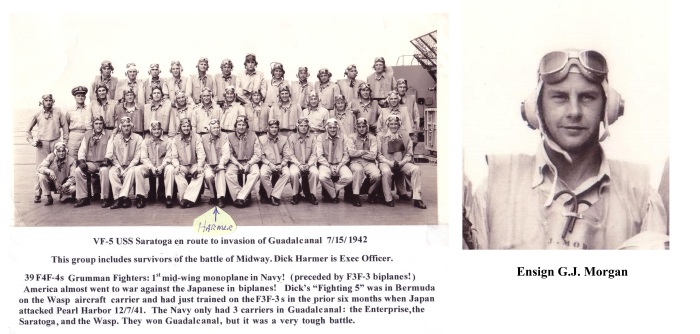Day: March 19, 2017
Remembering Ensign G. J. Morgan (? – 1942)

There is very little information on the Internet about Ensign G. J. Morgan.
See the link below.
https://missingmarines.com/2016/10/04/on-an-intercept/#comment-11546
What happened to George Treptow between the squadron’s scramble and return to base may never be fully known. Historian Lundstrom states that Treptow “chased the main body” of the Marine force, and was “climbing alone” to the fight.[2] His aircraft may have been suffering from engine trouble; at least four other pilots, including Marion Carl, complained of similar trouble. The Wildcats’ breathing apparatus was notoriously faulty; oxygen deprivation may have slowed his reflexes and made it impossible to reach altitude. Whatever the cause, George Treptow was missing. So was his squadron leader, Major Galer; so were Major Smith, Bill Lees, and 2Lt. Charles Kendrick from VMF-223, and a Navy pilot, Ensign G. J. Morgan. The dismayed pilots only claimed four Japanese shot down.
To contact me you can write a comment or use this contact form.
Remembering Ensign Mortimer “Junior” Kleinmann Jr.
Source
http://www.pacificwrecks.com/aircraft/f4f/5192.html
Aircraft History
Built by Grumman. Delivered to the U. S. Navy on April 1, 1942.
Wartime History
During early April 1942, assigned to squadron VF-5 “Fighting Five” aboard USS Saratoga (CV-3). This Wildcat was assigned the tail number F-12. VF-5 was the only Navy squadron to retain the letter F designator. Nicknamed “Junior” in small black letters beneath the cockpit by Ensign Mortimer Kleinmann, Jr.
Ensign Mortimer Kleinmann, Jr.
Mission History
On August 7, 1942 took off from USS Saratoga at 10:48am on a mission to intercept the first Japanese air raid against Guadalcanal. In the rush to intercept, James “Pug” Southerland boarded this Wildcat, usually flown by Ensign Mortimer Kleinmann.
James “Pug” Southerland
At 12:51pm, Southerland shot down a G4M1 Betty bomber of the 4th Kōkūtai, under the command of Shizuo Yamada, the first Japanese aircraft shot down of the Guadalcanal campaign.
After shooting down the bomber, he was engaged by A6M2 Zeros from the Tainan Kōkūtai, including Saburo Sakai. Following a lengthy dog fight, this Wildcat was hit by both 7.7mm machine gun then 20mm cannon fire and severely damaged. Southerland managed to bail out just moments before the damaged aircraft exploded before crashing into the ground.
After shooting down this Wildcat, Saburo Sakai made a solo attack against a formation of SBD Dive Bombers, mistaking them as more fighters. As he closed to attack, the dive bomber’s rear gunners opened fire and hit his Zero and severely wounded him. Although wounded, Sakai managed to fly back to base, blinded in one eye in his heavily damaged Zero.
Officially, this Wildcat was not removed from the Navy list until September 30, 1942. This aircraft was the first American aircraft shot down during the Guadalcanal campaign. The dogfight when it was lost is documented air combats of the Pacific War, as both pilots survived to record their experiences.
Fate of the Pilot
After bailing out, Southerland bailed out and parachuted to the ground unhurt. He was met by Solomon Islander Bruno Nana who helped him to reach American lines. On August 20, 1942, Southerland was evacuated from Guadalcanal on the first PBY Catalina to land at Henderson Field. He later returned to combat and became an ace himself, and awarded the Distinguished Flying Cross (DFC).
Wreckage
This Wildcat exploded at low altitude moments before impacting the ground. The wreckage landed in a ravine covered with dense jungle. Most parts have been well preserved by thick foliage protection. Black stenciling is visible on both sides of the fin “NAVY 5192”, and a stencil on the inside of a cowl flap “5192”. Parts of the left elevator still had intact camouflaged fabric on them. Three Browning .5 caliber machine guns were located, as was the engine, with two cylinders cleanly removed through combat damage, and bullet holes in the prop.
From the book…
I strongly believe Ensign Kleinmann survived the war.
To contact me…








